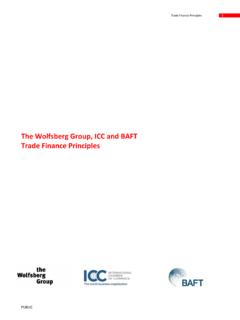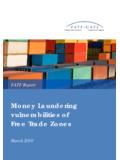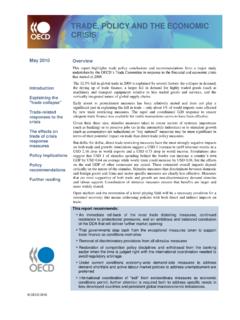Transcription of APG Trade Based Money Laundering Typologies Report 2012 …
1 ASIA/PACIFIC GROUP ON Money Laundering APG Typology Report on Trade Based Money Laundering Adopted by APG Members at the 15th Annual Meeting 20 July 2012 2. 2012 ASIA/PACIFIC GROUP ON Money Laundering ; All rights reserved. No reproduction or translation of this publication may be made without prior written permission. Requests for permission to further disseminate, reproduce or translate all or part of this publication should be obtained from APG Secretariat, Locked Bag A3000, Sydney South, NSW 1232, Australia. (Telephone: +612 9277 0600 Fax: +612 9277 0606 Email: 3 Table of Contents EXECUTIVE SUMMARY .. 4 KEY FINDINGS .. 5 POLICY OBSERVATIONS .. 6 CHAPTER I SCOPE & COVERAGE .. 8 INTRODUCTION .. 8 AIMS OF THE STUDY .. 8 SCOPE OF THE STUDY .. 9 METHODOLOGY .. 11 FRAMEWORK .. 11 REVIEW OF EXISTING STUDIES .. 12 CHAPTER II STATISTICAL ANALYSIS .. 22 EXTENT AND PREVALENCE OF TBML PROBLEM .. 22 ROLE OF AGENCIES RESPONSIBLE FOR TACKLING TBML.)
2 25 DOMESTIC & INTERNATIONAL COOPERATION AND TRAINING .. 29 Trade TRANSPARENCY UNITS (TTU) .. 31 PATTERNS OF financial PRODUCTS USED .. 33 RED FLAGS AND PATTERNS .. 33 PREDICATE OFFENCES OF TBML .. 38 CHAPTER III Trade FINANCE .. 39 SIGNIFICANCE OF TBML .. 39 THE Trade FINANCE ENVIRONMENT .. 40 CASH Based ECONOMIES .. 41 INSTRUMENTS OF Trade FINANCE & THEIR VULNERABILITIES .. 42 USEFUL TIPS FOR TBML INVESTIGATORS .. 49 CHAPTER IV CASE STUDIES .. 52 CASE STUDY 1 (INFORMATION PROVIDED BY INDIA) .. 52 CASE STUDY 2 (INFORMATION PROVIDED BY SINGAPORE) .. 54 CASE STUDY 3 (INFORMATION PROVIDED BY USA) .. 56 CASE STUDY 4 (INFORMATION PROVIDED BY INDIA) .. 59 CASE STUDY 5 (INFORMATION PROVIDED BY MACAO, CHINA) .. 60 CASE STUDY 6 (INFORMATION PROVIDED BY USA) .. 62 CASE STUDY 7 (INFORMATION PROVIDED BY INDIA) .. 64 ALTERNATIVE REMITTANCE SYSTEMS: .. 69 CONCLUSIONS .. 70 CHAPTER V CONCLUSIONS .. 72 CHALLENGES .. 72 THE WAY FORWARD .. 74 ANNEX A TBML RED FLAGS FROM CURRENT & EXISTING STUDIES.
3 78 ANNEX B SUMMARY OF RESPONSES TO THE APG TBML QUESTIONNAIRE .. 86 PROJECT TEAM .. 93 4 EXECUTIVE SUMMARY EXECUTIVE SUMMARY 1. Trade Based Money Laundering (TBML) was recognized by the financial Action Task Force (FATF) in its landmark 2006 study as one of the three main methods by which criminal organizations and terrorist financiers move Money for the purpose of disguising its origins and integrating it back into the formal economy. This method of Money Laundering (ML) is Based upon abuse of Trade transactions and their financing. The 2006 FATF Study highlighted the increasing attractiveness of TBML as a method for Laundering funds, as controls on Laundering of funds through misuse of the financial system (both formal and alternate) and through physical movement of cash (cash smuggling) become tighter. 2. In recent years APG members have continued to highlight vulnerabilities for TBML, but very few cases investigations or prosecutions appear to have been undertaken in the Asia/Pacific region and very few case studies had been shared.
4 3. The APG s TBML study aims to build on the existing studies, in particular those of the FATF, in order to study the extent of the prevalence of TBML and highlight current methods, techniques and modus operandi for TBML as well as to identify red flags to detect and respond to TBML. 4. In determining the magnitude of TBML, the study considered why so few cases of TBML have been detected since the FATF s 2006 study. The Paper has sought to clarify and furnish explanations for terms and processes of Trade finance which are comprehensible to Money Laundering (ML) investigators. 5. This Paper has focused on TBML occurring in the course of international Trade in goods. The study does not include in its scope capital flight, tax evasion, Trade in services and domestic Trade . The features of the dynamic environment that distinguish TBML from other forms of ML are its occurrence through intermingling of the Trade sector with the Trade finance sector in cross- border transactions.
5 The foreign exchange market and the long supply chain make international Trade particularly vulnerable to TBML. 6. The study included circulation of a questionnaire to APG and FATF members seeking statistically significant indicators. The Paper sets out a number of Case Studies to illustrate trends of TBML. Simplified explanations of the terms and processes of Trade finance have been attempted through interaction with the private sector. A brief review of the literature on the subject generated by the FATF, FSRBs and other authors has been made. 7. There is a growing concern on how the rapid growth in the global economy has made international Trade an increasingly attractive avenue to move illicit funds through financial transactions associated with the Trade in goods and services. TBML is a complex phenomenon since its constituent elements cut across not only sectoral boundaries but also national borders.
6 The dynamic environment of international Trade allows TBML to take multiple forms. 5 KEY FINDINGS 8. Statistical analysis has been conducted on the basis of responses received on 64 questions from 19 jurisdictions and 1 organisation. 9. Few TBML cases have been reported. The extent of TBML in the region was not able to be accurately estimated in this study. However, during the course of the study it has become evident that TBML is a problem for many of the participating jurisdictions and has serious significance as an avenue to launder proceeds of crime. 10. There is lack of awareness and training on TBML among the jurisdictions. Training for those responsible for detection and investigation of TBML as well as to those who collect Trade data and handle Trade finance is critical to raise their awareness about TBML and build capacity to identify TBML. 11. Most jurisdictions do not distinguish TBML from other forms of ML.
7 A major obstacle in devising strategies to tackle TBML has been the lack of reliable statistics relating to it. There is presently no standardization with regard to the practice of collection and maintenance of data on TBML. Trade related data is collected to serve purposes other than those of detecting TBML. 12. The lack of TBML investigators and absence of systems capable of cross-referencing Trade and Trade finance data are significant limitations. In most of the reporting jurisdictions customs authorities or equivalent collect and manage Trade data but do not have the authority to conduct ML investigation. 13. Over 50% of the reporting jurisdictions indicate referrals from other agencies which trigger TBML investigations. Again, over 50% of the reporting jurisdictions seek information from international counterparts. However there are impediments in domestic coordination and international cooperation among the competent authorities.
8 The main impediments which have been identified are requirement of maintaining confidentiality, delays in response and conveying of information with restrictions. 14. Reporting jurisdictions have listed a large number of patterns and red flags which this Paper has categorised in five broad groups viz. Trade Finance, Jurisdictions, Goods, Corporate Structure and Predicate Offences. The last four categories have been dealt with in the past papers under the broad category of Trade . With regard to Trade finance the important red flags relate to methods of payment and letters of credit. Existence of duty free zones and prevalence of high duty structure can make jurisdictions sensitive to TBML. The discrepancy about description, quality, quantity and value of the goods which are traded can be important red flags. Front or shell companies are often used as corporate structures to facilitate TBML.
9 Tax evasion and customs offences are important predicate offences for TBML. 15. The Trade finance products identified in this study reveal a menu of choices that are available to genuine traders to facilitate Trade . Exporters and importers enter into an agreement to Trade more often than not by way of cash payment or through some more 6complex form of Trade financing. Such Trade finance products include bills of exchange, counter Trade , letters of credit and open account facilities. A range of open account facilities may encompass factoring, forfaiting and other forms of credit. While the Trade finance products were innovated to reduce Trade transaction costs, their accessibility have also made them vulnerable to TBML abuse. Thus the Trade in commodity has become as good as means of movement of cash and of transfer of funds to indulge in Laundering .
10 16. financial sector representatives indicate a trend toward the use of open account financing in Trade . This has implications for detecting the abuse of Trade finance for ML. 17. The case studies included in the Paper, besides identifying the elements of Trade that facilitate TBML, also bring out the mechanisms of Trade finance used in TBML. One case study highlights the financing of different segments of Trade through diverse mechanisms of Trade finance that can introduce risks in the Trade transactions which are difficult to assess by financial institutions. The mechanisms of financing Trade through factoring and through disbursement of Trade credit to overseas suppliers are fraught with risks for financial institutions unless due diligence is exercised over the overseas trading partner, are brought out in another case study. Another case study shows how the operations of exchange houses owned and controlled by criminals coupled with compromised working of a bank make Trade finance mechanisms means for indulging in TBML.
















